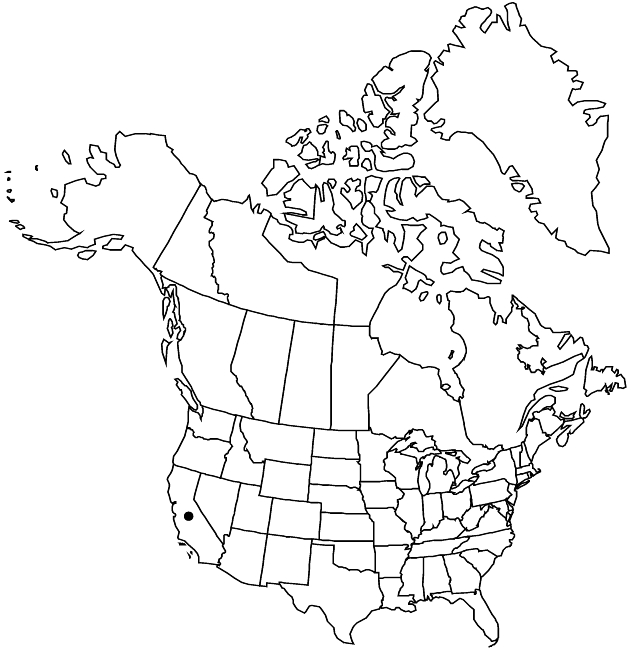Difference between revisions of "Heterotheca sessiliflora subsp. bolanderi"
Phytologia 73: 449. 1993.
FNA>Volume Importer |
imported>Volume Importer |
||
| (3 intermediate revisions by 2 users not shown) | |||
| Line 6: | Line 6: | ||
|place=73: 449. 1993 | |place=73: 449. 1993 | ||
|year=1993 | |year=1993 | ||
| + | }} | ||
| + | |special_status={{Treatment/ID/Special_status | ||
| + | |code=E | ||
| + | |label=Endemic | ||
| + | }}{{Treatment/ID/Special_status | ||
| + | |code=C | ||
| + | |label=Conservation concern | ||
}} | }} | ||
|basionyms={{Treatment/ID/Basionym | |basionyms={{Treatment/ID/Basionym | ||
|name=Chrysopsis bolanderi | |name=Chrysopsis bolanderi | ||
|authority=A. Gray | |authority=A. Gray | ||
| + | |rank=species | ||
|publication_title=Proc. Amer. Acad. Arts | |publication_title=Proc. Amer. Acad. Arts | ||
|publication_place=6: 543. 1866 | |publication_place=6: 543. 1866 | ||
| Line 16: | Line 24: | ||
|name=Chrysopsis arenaria | |name=Chrysopsis arenaria | ||
|authority=Elmer | |authority=Elmer | ||
| + | |rank=species | ||
}} {{Treatment/ID/Synonym | }} {{Treatment/ID/Synonym | ||
|name=Chrysopsis villosa var. bolanderi | |name=Chrysopsis villosa var. bolanderi | ||
|authority=(A. Gray) A. Gray | |authority=(A. Gray) A. Gray | ||
| + | |rank=variety | ||
}} {{Treatment/ID/Synonym | }} {{Treatment/ID/Synonym | ||
|name=Heterotheca bolanderi | |name=Heterotheca bolanderi | ||
|authority=(A. Gray) V. L. Harms | |authority=(A. Gray) V. L. Harms | ||
| + | |rank=species | ||
}} | }} | ||
|hierarchy=Asteraceae;Asteraceae tribe Astereae;Heterotheca;Heterotheca sessiliflora;Heterotheca sessiliflora subsp. bolanderi | |hierarchy=Asteraceae;Asteraceae tribe Astereae;Heterotheca;Heterotheca sessiliflora;Heterotheca sessiliflora subsp. bolanderi | ||
| Line 38: | Line 49: | ||
|distribution=Calif. | |distribution=Calif. | ||
|discussion=<p>Of conservation concern.</p><!-- | |discussion=<p>Of conservation concern.</p><!-- | ||
| − | --><p>Subspecies bolanderi is known from Mendocino to San Mateo counties and is rare south to n Monterey County near the coast and at lower elevations around San Francisco Bay. The few collections from northwestern Washington came from sandy sites near the ocean. None are typical for < | + | --><p>Subspecies bolanderi is known from Mendocino to San Mateo counties and is rare south to n Monterey County near the coast and at lower elevations around San Francisco Bay. The few collections from northwestern Washington came from sandy sites near the ocean. None are typical for <i></i>subsp.<i> bolanderi</i>, but they would be aberrant in <i>Heterotheca villosa</i>. These were likely chance introductions that did not persist.</p><!-- |
| − | --><p>Subspecies bolanderi is distinguished by its arrays with few, large heads, flat leaf margins, long hairs, and large cypselae with long pappi bristles. Corolla lobe hairs are often very few and sometimes difficult to find, especially in older heads past flowering. Plants from more upland habitats can be confused with (< | + | --><p>Subspecies bolanderi is distinguished by its arrays with few, large heads, flat leaf margins, long hairs, and large cypselae with long pappi bristles. Corolla lobe hairs are often very few and sometimes difficult to find, especially in older heads past flowering. Plants from more upland habitats can be confused with (<i></i>subsp.<i> echioides</i>) var. bolanderioides, which tends to have easily seen, very long hairs attached to the corolla lobes and tubes. Plants from Mendocino often have long peduncles, while those from around San Fransico Bay tend to have shorter peduncles and more congested arrays.</p> |
|tables= | |tables= | ||
|references= | |references= | ||
| Line 48: | Line 59: | ||
-->{{#Taxon: | -->{{#Taxon: | ||
name=Heterotheca sessiliflora subsp. bolanderi | name=Heterotheca sessiliflora subsp. bolanderi | ||
| − | |||
|authority=(A. Gray) Semple | |authority=(A. Gray) Semple | ||
|rank=subspecies | |rank=subspecies | ||
| Line 62: | Line 72: | ||
|publication title=Phytologia | |publication title=Phytologia | ||
|publication year=1993 | |publication year=1993 | ||
| − | |special status= | + | |special status=Endemic;Conservation concern |
| − | |source xml=https:// | + | |source xml=https://bitbucket.org/aafc-mbb/fna-data-curation/src/2e0870ddd59836b60bcf96646a41e87ea5a5943a/coarse_grained_fna_xml/V19-20-21/V20_527.xml |
|tribe=Asteraceae tribe Astereae | |tribe=Asteraceae tribe Astereae | ||
|genus=Heterotheca | |genus=Heterotheca | ||
Latest revision as of 20:03, 5 November 2020
Stems sparsely hispido-strigose proximally. Cauline leaves: proximal subsessile to sessile, blades oblanceolate, margins entire, flat or weakly undulate, apices acute, faces usually moderately, rarely densely hispido-strigose, sparsely stipitate-glandular; distal sessile, blades oblanceolate or lanceolate, (13–)21–40 × (4–)5–7(–8) mm, often little reduced distally, margins flat, with large spreading cilia along much of length, faces moderately long-strigose, sparsely to moderately stipitate-glandular. Peduncle bracts 1–4, grading from leaves, lanceolate to linear distally, faces sparsely to moderately long hispido-strigose, sparsely to moderately stipitate-glandular; sometimes 1–3+ larger leaflike bracts subtending and exceeding involucres. Involucres 9–12.6(–15) mm. Ray florets (9–)12–18(–21); laminae 9–15(–20) mm. Disc florets: corolla tubes and throats glabrate, lobes glabrate to sparsely strigose (hairs 0.2–0.7(–1) mm). Cypsela faces moderately to densely strigose.
Phenology: Flowering Jun–Sep(–Oct).
Habitat: Dunes, headlands, open grassy slopes, cliffs, coastal terraces, roadsides in coastal scrub
Elevation: 0–200 m
Discussion
Of conservation concern.
Subspecies bolanderi is known from Mendocino to San Mateo counties and is rare south to n Monterey County near the coast and at lower elevations around San Francisco Bay. The few collections from northwestern Washington came from sandy sites near the ocean. None are typical for subsp. bolanderi, but they would be aberrant in Heterotheca villosa. These were likely chance introductions that did not persist.
Subspecies bolanderi is distinguished by its arrays with few, large heads, flat leaf margins, long hairs, and large cypselae with long pappi bristles. Corolla lobe hairs are often very few and sometimes difficult to find, especially in older heads past flowering. Plants from more upland habitats can be confused with (subsp. echioides) var. bolanderioides, which tends to have easily seen, very long hairs attached to the corolla lobes and tubes. Plants from Mendocino often have long peduncles, while those from around San Fransico Bay tend to have shorter peduncles and more congested arrays.
Selected References
None.
